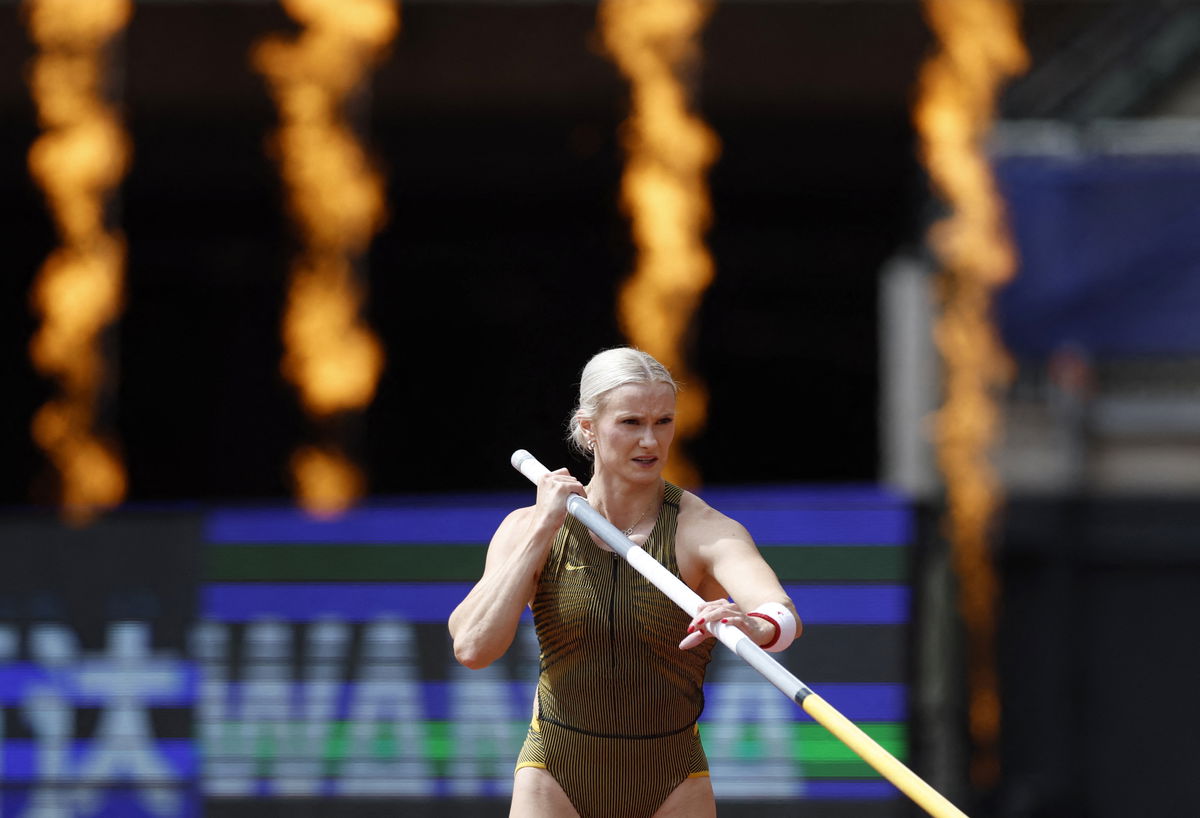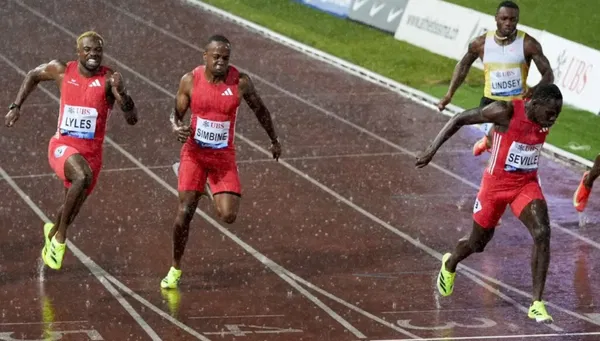
Reuters
Athletics – Diamond League – London – London Stadium, London, Britain – July 20, 2024 Katie Moon of the U.S. in action during the women’s pole vault Action Images via Reuters/Peter Cziborra

Reuters
Athletics – Diamond League – London – London Stadium, London, Britain – July 20, 2024 Katie Moon of the U.S. in action during the women’s pole vault Action Images via Reuters/Peter Cziborra
The Zurich forecast has cast an unusual shadow on one of track and field’s most prestigious stages. Updated projections for August 27 indicate only passing light rain, but Thursday is expected to bring a sharp turn in conditions, with temperatures dropping to 19°C and heavy rainfall throughout the day. For the second week in succession in Switzerland, a major storm is expected to strike precisely on the date of a Diamond League meet, forcing organizers to alter their program in advance.
Watch What’s Trending Now!
To guard against the threat, the women’s pole vault has been moved from Thursday to Wednesday afternoon at Sechseläutenplatz, the downtown plaza that traditionally hosts Zurich’s city events. The announcement followed safety evaluations that determined vaulting could not be held in rain-soaked circumstances. Wet poles, flooded planting boxes, and slick runways were judged to create unacceptable risks of injury. Organizers canceled the event because “slippery poles and hands” alone are enough to endanger athletes, and a water-filled planting box would make launching impossible. The competition will now begin on August 27 at 14:30, one day earlier than scheduled.
Talking about the scenario, track expert James Rhodes shared on X (@James_Athletics), “Due to the forecast for Thursday, the women’s pole vault at Zurich 💎has been moved forward a day. It will take place at 14:30 as part of the city event on Wednesday at the Sechseläutenplatz.” This decision immediately reshaped the outlook for three prominent American athletes.
ADVERTISEMENT
Emily Grove, Katie Moon, and Sandi Morris, all ranked among the world’s best in 2025, had centered their Diamond League seasons around Zurich as a decisive stage before the Brussels Final. Grove, ranked twelfth in the world, has been steady all year with two clearances at 4.73m, including one in Brescia last month. Her Diamond League record shows consistency, with a third-place finish in Paris and a current fifth-place standing in the league table with 24 points. Zurich was expected to be critical for her bid to secure a spot in Brussels.
Moon, the reigning world champion, has produced one of the most formidable seasons of her career. She swept her indoor campaign with victories at the National Pole Vault Summit, the Millrose Games, and Liévin, where she cleared 4.83m. Outdoors, she continued that success by winning in Rabat, Paris, and Brussels, her season-best 4.85m coming just five days before Zurich. With her ranking at world number two, Zurich was to be a final rehearsal before defending her title at the Tokyo World Championships in September.
Morris, meanwhile, returned to competition this year after battling a chronic shoulder injury. Opening her outdoor season with a 4.63m clearance in Doha, which she described as a “rust buster,” she has steadily rebuilt her form. Ranked third globally, she will also turn her attention to Tokyo, seeking her first outdoor world gold after three silvers.
ADVERTISEMENT
Due to the forecast for Thursday, the women's pole vault at Zurich 💎has been moved forward a day. It will take place at 14:30 as part of the city event on Wednesday at the Sechseläutenplatz.
— James Rhodes (@James_Athletics) August 26, 2025
The Zurich pole vault will not be a purely American contest.
ADVERTISEMENT
Swiss athletes Lea Bachmann and Roberta Bruni, Italy’s Angelica Moser, and Slovenia’s Tina Sutej are also there, providing a field that combines homegrown representation with established international medalists. Their presence highlights Zurich’s tradition of assembling competitive and diverse lineups, even under disruptive conditions.
For the Americans, however, the schedule shift is more than a minor inconvenience. Grove, Moon, and Morris must now recalibrate preparations by a full day, balancing travel, rest, and technical routines against a compressed timetable.
With rain projected to continue into the night of August 27 and intensify the following day, the change may ultimately prove decisive in keeping the event viable at all. What was meant to be a climactic Thursday evening contest will instead unfold in mid-afternoon, leaving three of the United States’ foremost vaulters to adapt swiftly in pursuit of season-defining performances. And this is not the first time.
ADVERTISEMENT
Just a week ago, severe rain and wind at the Lausanne Diamond League highlighted how climate change directly disrupted athletes’ performances and safety on the track.
Climate change storms derail Lausanne Diamond League as athletes battle brutal conditions
The Lausanne Diamond League, too, unfolded under conditions that reminded every competitor of forces far beyond the stopwatch. Heavy rain swept across the track, and unrelenting winds made even the simplest warm-up feel uncertain. Athletes accustomed to precision suddenly found themselves navigating surfaces that refused to cooperate, their focus torn between speed and survival. What should have been a straightforward stage for performance instead became a stark reminder of how a changing climate continues to intrude upon sport at the highest level.
ADVERTISEMENT

Imago
Credit: Liam Blackwell / www.diamondleague.com
Those who braved the conditions spoke candidly of their struggles.
Alessandro Collela admitted that “today was tough, because it was heavy rain. Conditions are not good at all, but it was difficult. I didn’t manage to run well, but it’s a great experience for the future!” Ramon Wipfli explained how quickly the weather undermined his attempt at world standards, confessing, “by 250 meters, the water had soaked my shoes, and it got really tough.” Even his determination to control the race could not offset the reality of the soaked track and the risks it carried. Their accounts were not isolated frustrations, but consistent evidence of an environment that made execution nearly impossible.
ADVERTISEMENT
Emma van Camp’s assessment left little room for debate. She described the downpour as among the “most horrible” conditions she had ever experienced, noting, “it was very hard to focus in this rain. I didn’t see the lines properly, so yeah, I was just focusing on the techniques and not pushing hard to get injured.” Her words captured the uneasy balance between ambition and caution that defined the evening.
Top Stories
Forced to Leave FOX, Cowboys Legend Troy Aikman Says ESPN Is Like ‘U.S. Government’ & Clearly Distinguishes the Two Networks

Who Is Paige Shiver? All About Michigan Football Staffer & Daughter of Veteran Bears Scout Jeff Shiver

FOX Issues Strict Ban on Terry Bradshaw But NFL Legend Defies It to Join Popular Morning Show

Michael Jordan Brings NASCAR to Its Knees as Jim France’s Courtroom Collapse Triggers Settlement

What Happened to T.J. Watt? Why Is He Hospitalized? Steelers Announce Latest News on LB Before Dolphins Game

LIV Golf to Cut Ties With Veteran Pro After His PGA Tour Return Intentions Became Public

The Lausanne meet revealed how swiftly adverse weather can neutralize preparation, leaving even the most accomplished athletes caught in battles that extend beyond their rivals.
ADVERTISEMENT
ADVERTISEMENT
ADVERTISEMENT

